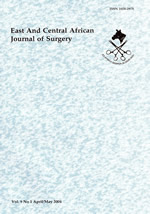
|
East and Central African Journal of Surgery
Association of Surgeons of East Africa and College of Surgeons of East Central and Southern Africa
ISSN: 1024-297X
EISSN: 1024-297X
Vol. 16, No. 3, 2011, pp. 64-68
|
 Bioline Code: js11052
Bioline Code: js11052
Full paper language: English
Document type: Research Article
Document available free of charge
|
|
|
East and Central African Journal of Surgery, Vol. 16, No. 3, 2011, pp. 64-68
| en |
Cold versus hot dissection tonsillectomies: The Nigerian experience
Adoga , A.A.
Abstract
Background:
Tonsillectomy is performed by various techniques but the commonest used in Nigeria is the cold dissection method. Our study highlights our experience from comparing the cold and hot dissection methods of tonsillectomy.
Methods:
This is a prospective randomized single-blind study spanning fifty seven months comparing operative time, intraoperative hemorrhage and postoperative morbidity such as hemorrhage and pain following both methods of tonsillectomy.
Results:
Thirty eight of 43 patients were studied aged between 10 years and 31 years with 21 (55.3%) males and 17 (44.7%) females, M:F ratio of 1.2:1. Removal of tonsils by cold dissection took an average of 11.14 (SD= 9.89) minutes and by diathermy, 9.10 (SD=7.86) minutes (p=0.001). Average intraoperative blood loss was 20mls for cold dissection and 25mls by diathermy. Thirty two (84.2%) patients consistently affirmed that the diathermy side was more painful than the cold dissection side. No postoperative hemorrhage. More eschar was noticed on the diathermy sides with less than 25% healing compared with the cold blunt dissection sides on the 7th postoperative day.
Conclusion:
From this experience, diathermy tonsillectomy has the advantage of shorter operative time but cold dissection tonsillectomy is still more advantageous because it is a safer and more effective method with lesser postoperative morbidity.
|
| |
© Copyright 2011 - East and Central African Journal of Surgery
|
|
